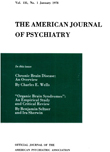A CURRENT EVALUATION OF THE ANTICONVULSANT DRUGS
Abstract
Definite advances have been made in the treatment of epilepsy during recent years. The bromides, then phenobarbital, and finally dilantin have in this order been found to be increasingly effective. Research on some of the newer hydantoin derivatives has given even more hope in the control of grand mal attacks. The ketogenic diet, glutamic acid, and finally tridione have been found to be helpful in the treatment of petit mal seizures, and tridione also in the alleviation of psychomotor attacks.
The therapeutic approach depends, of course, upon the underlying etiology and upon the type of attack from which the patient is suffering. Epilepsy, or the convulsive state, must not be regarded as a disease entity. The etiology differs in individual cases, and although grand mal, petit mal, psychomotor, and other varieties of attacks may occur in the same patient, each may be a manifestation of a different type of pathologic physiology. There may be a variability in symptoms from time to time; there may be no clear-cut distinction between one type of attack and another; there may be formes frustes which cannot be classified. The essential criteria should be not only an adequate description of the seizures and, if possible, observation of them, but also an electroencephalographic recording and an evaluation of the patient's personality and psychologic state. Specific therapies are now available for individual types of attacks and for specific abnormalities of the cerebral rhythm. The various anticonvulsants often have a definite synergistic effect, and a combination of 2 or more of them may be more helpful than any one alone; such combinations may be tried when individual drugs, used singly, do not control attacks. In a mixed type of epilepsy one may use phenobarbital, dilantin or Mesantoin with tridione.
One must bear in mind, however, that the use of the anticonvulsant drugs does not constitute the sole treatment of epilepsy. The underlying etiologic factors must be determined, if possible, and in addition to drugs one often must use physical measures, diet, mental hygiene, and occasionally surgery. By knowing the mode of action of all the possible therapeutic agents, and by a careful, detailed study of each patient, the physician can, in most instances, control the symptoms of disease and return the patient to a useful life.
Access content
To read the fulltext, please use one of the options below to sign in or purchase access.- Personal login
- Institutional Login
- Sign in via OpenAthens
- Register for access
-
Please login/register if you wish to pair your device and check access availability.
Not a subscriber?
PsychiatryOnline subscription options offer access to the DSM-5 library, books, journals, CME, and patient resources. This all-in-one virtual library provides psychiatrists and mental health professionals with key resources for diagnosis, treatment, research, and professional development.
Need more help? PsychiatryOnline Customer Service may be reached by emailing [email protected] or by calling 800-368-5777 (in the U.S.) or 703-907-7322 (outside the U.S.).



